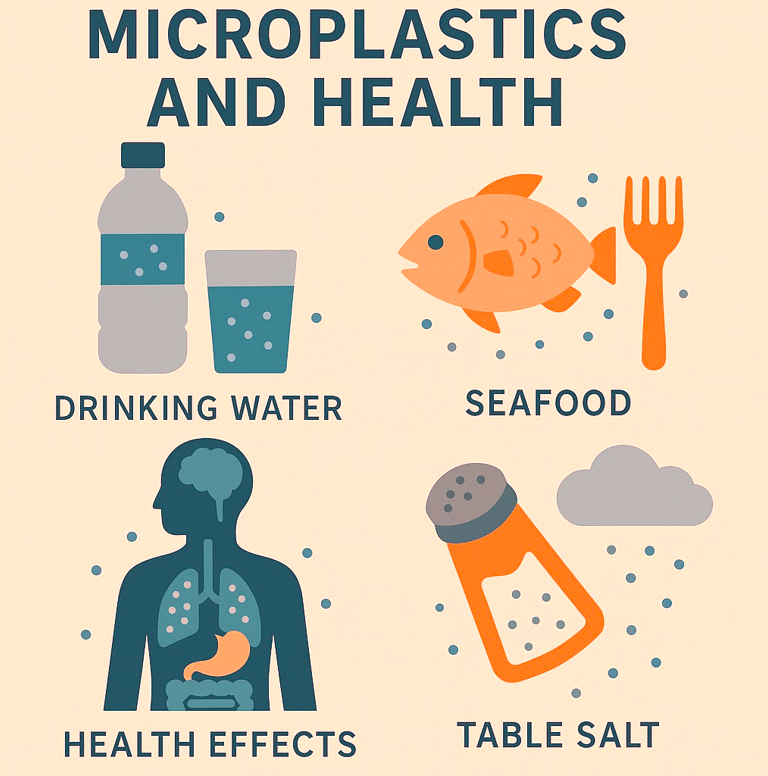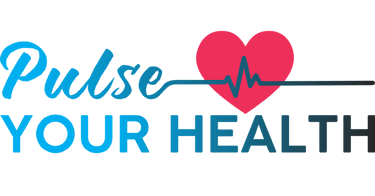Stay updated on what is trending in health. Discover tips and resources for a healthier, balanced life.
Are Microplastics Harming Your Health?
Microplastics are everywhere—from water to food to air—and may impact your health. Learn how they affect the body, what the science says, and how diet and lifestyle can help reduce their impact.
WELLNESS
Dr. S. Ali
8/2/20255 min read


We’ve all heard about plastic pollution in oceans, but what about the tiny bits of plastic you can’t see—the ones hiding in your food, water, and even the air you breathe? These microscopic pieces, called microplastics, are everywhere. And yes, they might be affecting your health more than you realize.
Let’s break it down.
What Are Microplastics, Exactly?
Microplastics are tiny plastic particles less than 5 millimeters long—about the size of a sesame seed or smaller. Some come from larger plastic items that break down (think plastic bottles and bags), while others are intentionally made small, like microbeads once used in scrubs and toothpaste.
They’re in our oceans, lakes, soil… and now, studies show, inside the human body.
Where Are We Getting Exposed?
You’d Be Surprised Where Microplastics Show Up:
Drinking water – both bottled and tap water:
Studies have detected microplastic particles even in filtered tap water—though bottled water often contains significantly more due to packaging and microplastic shedding during bottling and transport.
Seafood – especially shellfish like mussels and oysters:
These filter-feeders actively concentrate microplastics from the water. Eating them can deliver concentrated plastic particles directly into the body.
Table salt – processed from sea sources:
Research shows that sea salt often contains microplastic fragments absorbed from the ocean during evaporation and processing stages.
Food packaging – plastics can leach into food, especially when heated:
Heat, grease, and acidity can promote plastic breakdown, causing tiny fragments or chemicals to migrate into your meal.
Air – yes, we can even inhale them:
Microplastics are increasingly found in household and indoor air. In fact, a new study published on PLOS One, by scientists from the University of Toulouse, France, reveals that indoor air levels are 100 times higher than previously thought. Adults may inhale around 70,000 microplastic particles per day, the majority smaller than 10 micrometers—small enough to penetrate deep into the lungs, carry toxic additives, and potentially affect multiple organ systems including respiratory, endocrine, and cardiovascular health .
Airborne Exposure and Pandemic Impact:
Besides food and water, microplastics can also be inhaled from the air. The COVID-19 pandemic worsened this problem—widespread mask usage and poor disposal practices have led to a surge in polypropylene-based plastic pollution in the environment.
Are Microplastics Harmful to Your Health?
Here’s the honest answer: We’re still learning. But early research raises real concerns.
1. Inflammation and Oxidative Stress
Animal studies show that microplastics can trigger inflammation and oxidative stress—two major drivers of chronic disease. These particles may irritate tissues and even mess with how your cells function.
2. Endocrine Disruption
Some plastics contain chemicals like BPA, phthalates, and other endocrine disruptors. These can interfere with hormone balance, potentially affecting metabolism, fertility, and even developmental health in children.
The chemicals used in plastics—such as additives and monomers—can interfere with the body’s hormonal balance (endocrine disruption), weaken the immune system, and have been linked to reproductive harm and even cancer in laboratory models.
3. Gut Health Impact
Microplastics can disrupt your gut microbiome, the community of bacteria that helps regulate digestion, immunity, and inflammation. A damaged gut may mean more systemic issues down the line.
4. Potential for Long-Term Accumulation
We don’t yet know how—or if—our bodies clear microplastics effectively. Could they build up in organs or tissues over time? Some researchers worry they might.
Animal studies show that once microplastics enter the bloodstream, they can travel to organs like the liver, spleen, lungs, heart, kidneys, and even cross the blood–brain barrier. This suggests their potential to cause systemic effects throughout the body.
Microplastics as Pollutant Carriers
Microplastics don’t just harm on their own—they can also carry toxic substances like persistent organic pollutants and heavy metals, transferring them from small marine organisms up the food chain to humans.
But Isn’t Everyone Exposed?
Yes—but exposure levels vary. And while we can’t avoid microplastics completely, we can reduce our intake and support our body’s defenses. It’s like pollution—we may breathe some in, but we don’t want to live in smog 24/7.
How to Reduce Microplastic Exposure
Here are a few simple changes that can make a real difference:
Use less plastic
Swap single-use plastics for glass, stainless steel, or silicone alternatives.Avoid heating food in plastic containers
Heat can release more plastic particles into your food—especially in the microwave.Drink filtered water
Some home filters can reduce microplastic content. Reverse osmosis systems are among the most effective.Eat fewer processed foods
Heavily packaged, processed foods tend to have higher plastic contact. Fresh, whole foods are safer (and healthier overall).Limit bottled water
Studies have found microplastics in bottled water at much higher levels than tap water.Choose natural fabrics
Synthetic clothes (like polyester) shed microplastics when washed. Opt for cotton, linen, or wool when possible.
Can You Detox Microplastics from Your Body?
Right now, there’s no proven way to completely remove microplastics from the body once they’re inside. However, you can support your body’s natural detox pathways to help reduce potential harm:
Eat antioxidant-rich foods (berries, leafy greens, green tea) to fight oxidative stress.
Get enough fiber to support gut health and regular elimination.
Drink plenty of water to support kidney and liver function.
Exercise regularly, which boosts circulation and cellular repair.
Avoid new exposure—reduce plastic use, choose glass or stainless steel, and filter drinking water.
More research is needed, but keeping your detox organs healthy gives your body the best chance to manage and eliminate what it can.
Can Diet Help Protect You?
While there’s no food that can directly flush microplastics from your system, or prevent from them entering your body, the right diet can help your body manage the stress they cause and support its natural detox processes.
Here’s how:
Antioxidant-rich foods like berries, leafy greens, turmeric, and green tea help combat the oxidative stress caused by microplastics.
High-fiber foods such as flaxseeds, oats, beans, and vegetables support gut health and aid in waste removal through digestion.
Anti-inflammatory foods—like fatty fish, olive oil, garlic, and cruciferous vegetables—help keep your immune system balanced and reduce chronic inflammation.
Hydration is essential. Drinking plenty of clean, filtered water supports your liver and kidneys—your body’s primary detox organs.
Regular movement and exercise can enhance circulation and cellular repair.
In short, you can’t “detox” microplastics completely, but eating well helps your body stay resilient, reduce harm, and function at its best.
Bottom Line
Microplastics are a growing environmental and health concern. While the full impact is still being uncovered, early evidence suggests they can affect our health in subtle but serious ways—from inflammation to hormone disruption.
The good news? You don’t have to panic—but you can take smart steps to reduce your exposure. Choose safer materials, eat clean, and support your body with whole foods.
We can’t avoid microplastics completely—but we can reduce their impact, starting today.
Sources:
Harvard Health
https://www.health.harvard.edu/heart-health/microplastics-in-arteries-linked-to-heart-disease-riskFrontiers in Environmental Science
World Economic Forum
https://www.weforum.org/agenda/2023/11/how-microplastics-get-into-the-food-chain/Mayo Clinic
NIH -- National Library of Medicine
https://pmc.ncbi.nlm.nih.gov/articles/PMC9920460/PLOS One
Pulse Your Health
Empowering you to achieve your health goals.
Contact
© 2025. All rights reserved.
Disclaimer: The content on this website is for informational purposes only and is not medical advice. Always seek the advice of your physician or other suitably qualified healthcare professional for diagnosis, treatment and your health related needs.
